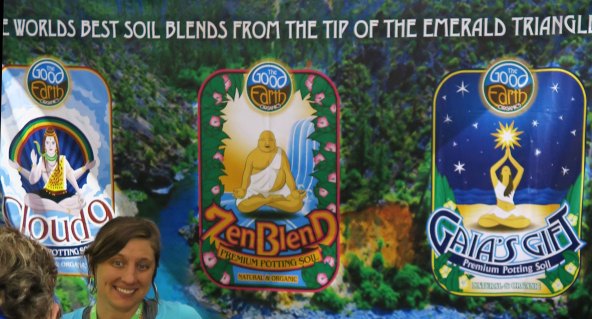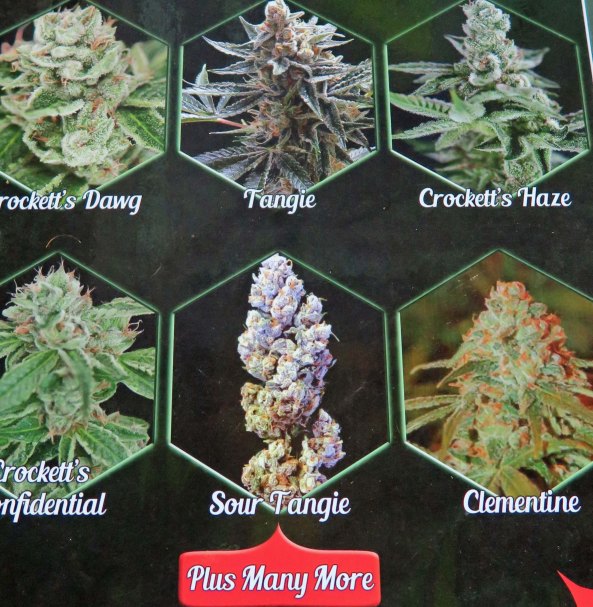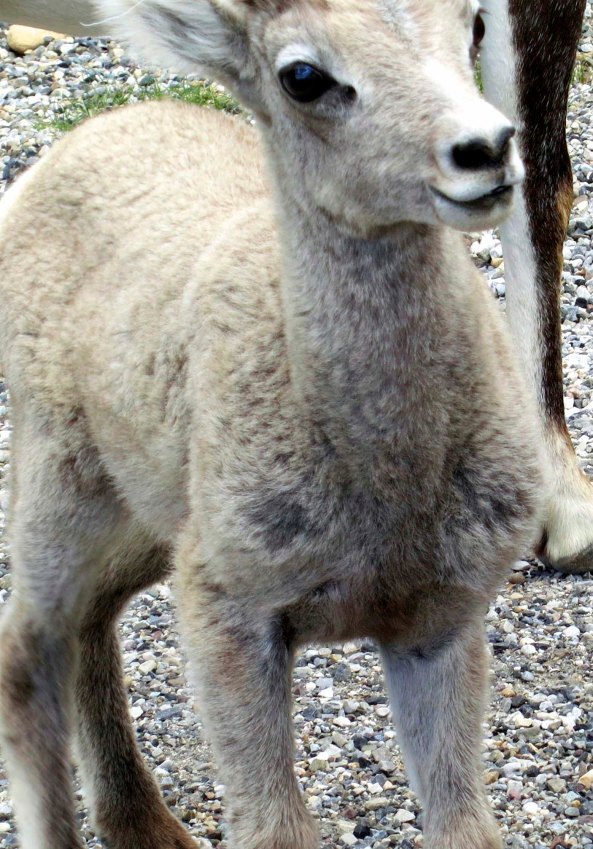
I didn’t know what type of things I would find at the Cannabis Fair, but a painting of George standing in the middle of a marijuana farm and glowing green wasn’t one of them.
Occasionally, I slip in a blog that is outside of my 10,000-mile bicycle trek series. Today we are going to a cannabis fair…
So here I was on Saturday morning, staring out our windows at the mountains, listening to the morning news on TV, and wondering what I was going to do with my day. Peggy was back East playing with the kids and grandkids. I had just put up my post on the Scopes Trial, responded to all my comments, and checked in on the people I follow. I was actually caught up on blogging, a rare occasion— as most of you bloggers will recognize.
The weather person was predicting a 110° F degree-day. Playing or working outside wasn’t an option and I had completed most of my indoor chores. In fact, I had just pushed Robota’s button (Robota is our iRobot vacuum cleaner), and she was charging around, sucking up dirt, and cleaning rugs and floors. She’d return to her dock and plug-in when she needed recharging. I do wish she would learn to clean out her dirt bin, though. It’s such a bother; I could use the two minutes for something else… (Grin)
In other words, I had time on my hands. What’s a fellow to do? That’s when the local television anchor announced that the Cannabis Fair was being held at the Jackson County Fairgrounds in the main exhibit hall. Now I love fairs, and I have been seriously deprived this year (if you don’t count the Fur Rendezvous in Anchorage, Alaska and the International Ice Carving contest in Fairbanks). We missed the local Jackson County Fair because we had to go to Sacramento and arrived in Sacramento just as the California State Fair ended. To top off this tale of woe, I am taking a break from Burning Man.
But go to the Cannabis Fair and blog about it? No way! What would people think? And then I thought, why not. Marijuana is now legal in Oregon. In fact, I voted for the measure to legalize it. The majority of Americans support the idea. Why? One reason is that prohibition doesn’t work; it never has. Look at what happened with alcohol in the 1920s. If people wanted a drink, they found it. The main result of the Prohibition was the creation of the American Mafia. The Mob Museum in Las Vegas provides an excellent history of how it happened.
A similar thing happened with marijuana. Smoking a joint in the 1950s could lead to a 10-year prison sentence and a fine of $20,000— for a first time offender. Did this stop marijuana use? Remember the 60s? I do, vaguely (kidding). Our demand for marijuana, combined with laws against cultivation, led to its illegal production. What a surprise. Millions, and even billions of dollars were to be made. Drug cartels sprang up like weeds outside of the US to supply us. Tragically, thousands have been killed and whole political systems corrupted as a result. Here, billions of tax dollars (that is your money and mine) have gone into creating large government agencies that haven’t made a dent in the flow of pot.
Maybe the billions we spent on trying to suppress marijuana would be worth it, if the drug were the devil it was portrayed to be in Reefer Madness and other such anti-pot campaigns. But the truth is— it isn’t. The negative physical and social impacts are no worse than alcohol, and may indeed be less. A growing body of evidence suggests that a number medical benefits derive from cannabis. Contrast this with the health effects of tobacco. Numerous states have passed laws making medical marijuana use legal. And several have now made it legal for recreational use as well.

I am not sure what the artist had in mind with this cloth hanging I found at the Fair, but I thought it provided a good perspective on how people view the effects of marijuana. On the left is the perspective of the cannabis industry, the pro-legalization forces and most users. On the right is how those who support the Reefer Madness point of view see it.
But it’s time to climb down off my soapbox (sort of). We have a fair to go to! I didn’t have a clue about what I was going to find. Let me start with noting there were no pigs, or goats, or bunny rabbits— the usual reasons I go to a fair. This was a serious endeavor. Pot growing is big business for small farms in my neck of the woods. Six are visible along the 30-mile road between where I live on the Applegate River and Medford. They hardly blend in.
The law requires that marijuana farmers put their crops behind 8-foot fences if they are located within 150 feet of the highway, supposedly to protect children from seeing them. Instead the fences serve as huge billboards that scream: WE GROW POT! If you can find a six-year-old in Jackson County that doesn’t know what is happening behind those fences, I’d be surprised. And you can bet they are much more intrigued by the hidden marijuana than they would be if the plants were simply grown out in the open like any other crop. Plus the fences are butt-ugly.

This fence, legally required by Oregon law to conceal a cannabis farm, is about a mile away from my house.
I wandered around from booth to booth at the fair, taking photos for my blog (after asking permission) and chatting with folks tending the booths. There was potting soil and pot pots. There were salves and seeds. There were lawyers and accountants and security specialists and equipment sales people. One man was offering a bud trimmer for $300 that looked like a combination of an electric razor and a mini-hedge trimmer. He provided a demonstration. Bzzzzzz! I could picture him at a cannabis shop saying, “This Bud’s for you.”

I couldn’t help but think pot pots when I saw these. And please note: they are made in the USA.

And of course you need premium potting soil for pot pots. What better than Cloud 9, Zen Blend, and Gaia’s Gift?

And you have to decide what type of cannabis you are going to plant. There are literally hundreds of strains that have been developed, all with different strengths, and, if you accept the literature, qualities.I wonder which one will give me an irresistible craving for ice cream?

In addition to all of the services available for growers at the Cannabis Fair, there were also items for consumers, such as these magical butter pots. Grind up your cannabis, drop it in the pot, add butter, simmer for an hour, strain, and you are ready to make cookies!
I wandered into a dome tent set up by Pacific Domes. It reminded me of the structures at Burning Man. Even some of the wall hangings seemed familiar. And there was the painting of George Washington enjoying a pipe I featured at the top of the blog. Robert, the account executive, told me that a lot of their tents do make it to Burning Man. I asked him how they handled the windstorms. “They are designed to withstand gusts up to 8o miles per hour,” he told me.

Both domed tents and greenhouses were promoted at the fair for growing marijuana.

The tent was appropriately camouflaged.

The wall hangings in the tent reminded me very much of Burning Man, although you don’t flaunt marijuana use in Black Rock City. The event is crawling with law enforcement people happy to bust you.
All types of pipes were available for smoking, some even glowed in the dark under a black light. The folks at Bayshore Smoking Glass from Coos Bay broke out several for me to photograph. Some of the pipes were quite attractive, and some were downright funny. How would you like your pot pipe to look like an octopus?

I found the variety of pipes fun. What can I say. An incredible amount of creativity goes in to producing them.

They come in all shapes, sizes and colors.

This one even glowed in the dark.

Dianne told me I could photograph her art work if I put her card in the picture.

I also found these bongs, or water pipes, rather unique.
Maybe you aren’t into smoking but still want to indulge. Then there are edibles, or medibles for medical marijuana. I stopped by a booth featuring Mary Lou’s Edibles and talked with Mary Lou. She had some delicious looking peanut butter cookies on display. “Are these samples?” I asked. (While no marijuana was for sale at the fair, some booths were offering free samples that you were required to take off of the premises before consuming.) “No,” she said, “but you can go online and order them.” She handed me her card. It announced, “Made with Oregon Cannabis and Love by the Happy Granny.” I’ll bet she is.

The rules were quite clear about not consuming marijuana at the Fair. Oregon state law prohibits consumption in public areas.

Kettle Corn anyone? A number of booths had edibles on display. They ranged from kettle corn, to chocolate, to cookies, to brownies and candy. An important issue is keeping these products away from children.

When edibles are used for medical purposes, they are called ‘medibles.’ I share a concern with the cannabis industry that the pharmaceutical industry will step in, patent medicines, and charge a hundred times more for medical marijuana than people presently pay. I feel the same way about agribusiness stepping in and wiping out the thousands of small farms that now grow cannabis.
A series of lectures were being offered and I stopped by to listen to one being given by Pioneer Pete Gendron. Pete represents Oregon’s marijuana growers on the state level. I am assuming that his pioneer status comes from being one of Oregon’s original pot growers. He certainly looks the part. He is also a highly intelligent and articulate man. He talked about cannabis politics in Oregon. I learned the reason behind the 8-foot fences from him. I also learned that marijuana isn’t quite the water hog it is claimed to be. Alfalfa requires seven times as much water to grow.

Pioneer Pete Gendron was one of a number of people who made presentations at the Cannabis Fair on the various aspects of marijuana farming and consumption.
Today, the Drug Enforcement Agency, DEA, continues to label marijuana as a class-1 drug, on par with heroin. Pete told us that when the cannabis industry requested an opportunity to prove it didn’t belong at that level, the DEA said, “We can’t do that. It is a class-1 drug,” i.e. it is illegal to use so any evidence you gather using it is illegal. Makes complete sense, right. Have you ever read Joseph Heller’s Catch 22?
The times they are a-changing, however. Cannabis plants will join carrots and cabbages at this year’s Oregon State Fair. How much more mainstream can you go? California will vote on legalization for recreational use this fall. On the national level, the Democratic Platform includes a plank that would push for legalization nation-wide. It is only a matter of time.
That’s it for the break! It’s back to bicycling in my next blog. We have a mountain range to climb over: the Great Smokies!



























































